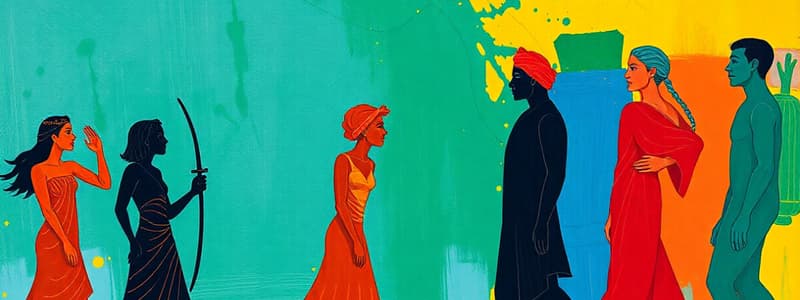Podcast
Questions and Answers
Which of these eras involved significant advancements in metalworking?
Which of these eras involved significant advancements in metalworking?
- Paleolithic Era
- Bronze Age (correct)
- Iron Age (correct)
- Neolithic Era
What period witnessed the emergence of settled communities and the development of agriculture?
What period witnessed the emergence of settled communities and the development of agriculture?
- Bronze Age
- Paleolithic Era
- Neolithic Era (correct)
- Iron Age
Which of these is NOT a key factor influencing historical development?
Which of these is NOT a key factor influencing historical development?
- Resources
- Political Systems
- Economic Stability (correct)
- Geography
Which period saw the rise of feudalism and the dominance of Christianity in Europe?
Which period saw the rise of feudalism and the dominance of Christianity in Europe?
Which period is characterized by the rise and fall of empires, the development of technology, and cultural shifts?
Which period is characterized by the rise and fall of empires, the development of technology, and cultural shifts?
What kind of evidence helps us understand societies that did not have written records?
What kind of evidence helps us understand societies that did not have written records?
Which of these are examples of social structures that impact societies?
Which of these are examples of social structures that impact societies?
Which of the following is NOT a challenge in studying history?
Which of the following is NOT a challenge in studying history?
What is the difference between primary and secondary sources in historical research?
What is the difference between primary and secondary sources in historical research?
What is a potential drawback of relying solely on oral histories for historical research?
What is a potential drawback of relying solely on oral histories for historical research?
Flashcards
Paleolithic Era
Paleolithic Era
The earliest period of human history characterized by stone tool use and a hunter-gatherer lifestyle.
Neolithic Era
Neolithic Era
The transitional period from hunting-gathering to agriculture, leading to settled communities.
Bronze Age
Bronze Age
A time when metalworking developed, leading to the rise of early civilizations like Mesopotamia and Egypt.
Renaissance
Renaissance
Signup and view all the flashcards
Scientific Revolution
Scientific Revolution
Signup and view all the flashcards
Social Structures
Social Structures
Signup and view all the flashcards
Primary Sources
Primary Sources
Signup and view all the flashcards
Secondary Sources
Secondary Sources
Signup and view all the flashcards
Bias in Sources
Bias in Sources
Signup and view all the flashcards
Oral Histories
Oral Histories
Signup and view all the flashcards
Study Notes
Chronological Overview
- Human history is a long and complex process spanning millions of years.
- It's characterized by continuous change and development.
- Early stages involved hunter-gatherer societies.
- Later, agricultural advancements led to settled communities and the emergence of civilizations.
- Subsequent periods saw the rise and fall of empires, technological innovations, and cultural shifts, shaped by various factors like geography, resources, and conflicts.
Key Periods and Events
- Paleolithic Era: Marked by the use of stone tools by early humans. Focus on survival.
- Neolithic Era: Transition to agriculture, leading to settled life and initial societal complexity.
- Bronze Age: Marked by the development of metalworking and the formation of early civilizations. Key civilizations included those in Mesopotamia and Egypt.
- Iron Age: Replaced bronze with iron, improving tools and weapons, and further societal advancement. Significant changes in warfare and technology.
- Classical Antiquity: Notable periods including Ancient Greece and Rome. Emphasis on philosophy, governance, and artistic expression.
- Medieval Period: Characterised by the rise of widespread feudalism and the dominance of Christianity in Europe.
- Renaissance: A period of cultural and intellectual rebirth following the Middle Ages, with renewed interest in classical learning. Significant achievements in art, science, and philosophy.
- Age of Exploration: European voyages of discovery led to global interconnectedness.
- Scientific Revolution: A period of remarkable scientific advancements. Key figures developed new ways of understanding the world.
- Industrial Revolution: Marked by major technological advancements and shifts in work and society.
- 20th and 21st Centuries: World Wars, technological advancements, globalization, and ongoing political and social changes.
Influences on Historical Development
- Geography played a crucial role in shaping where societies developed, trade networks, and opportunities.
- Resources: access to raw materials, like metals, influenced technology, trade, and economic strength.
- Political systems: Different forms of governance and their impact on societal structures.
- Cultural interactions: The exchange of ideas, beliefs, and practices between different societies.
- Technological innovation: Driven by necessity and curiosity. Crucial in shaping daily life, warfare, and economic development.
- Social structures: The way societies are structured affects social mobility, opportunities, and conflict. Examples include slavery, class systems, and gender roles.
- Religious and philosophical ideas: Greatly influenced worldviews and shaped social behavior and norms.
Historical Research Methods
- Primary sources: Original documents from the past, like letters, diaries, and government records. Provide direct insights.
- Secondary sources: Analyses and interpretations of primary sources, which offer broader context and analysis.
- Archaeological finds: Help us understand societies without written records. Artifacts and other remains provide clues about past lifestyles and cultures.
- Oral histories: Stories transmitted through generations, often providing unique insights into a culture's values and beliefs.
Challenges in Studying History
- Bias in sources: Historical accounts may be influenced by the viewpoints of those who created them. Understanding limitations is important.
- Reconstructing the past: Limited information may make it hard to accurately portray the past.
- Interpreting evidence: Different scholars may have varied interpretations and focus on different aspects of the past.
- Missing information: Some crucial records may no longer exist or be inaccessible, creating gaps.
Studying That Suits You
Use AI to generate personalized quizzes and flashcards to suit your learning preferences.




